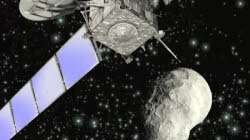New 3D camera for space missions—better imaging with less energy

On behalf of European Space Agency (ESA), Thales Alenia Space, SINTEF and Terma are now completing a study identifying alternatives to the cameras currently deployed on spacecrafts and space rovers.
Both ESA and NASA are on the lookout for better and less resource intensive camera systems for current and future space missions.
In the previous decades many applications involving traditional cameras and 2D-based imaging have been launched. The two agencies are now exploring the 3rd dimension for new high-quality camera systems that will give new opportunities in solving space missions.
From 2D to 3D cameras
The cameras currently used in space resemble the digital cameras in our mobile telephones, the main difference being they are of significant better quality. Cameras are used everywhere in space, from docking of space stations, during navigation on foreign planets and also for the safe landing of spacecrafts.
In these scenarios, 3D data is required for operations, even though the cameras are incapable of providing it themselves. Instead, 3D images are created by mounting several cameras together in so-called stereo configurations, and using complex computations to measure the third dimension. These computations are both power-hungry and potentially unreliable, making them less attractive for space usage.
Strength and weaknesses
Cameras that provide full 3D images became fully mature around 2000. Such cameras obtain the 3D data by emitting a coded light signal, and measuring the time it takes from the signal is emitted until it is reflected back to the camera (Time-Of-Flight measurement).
Numerous measurement principles and technologies exist for obtaining these measurements. A core part of the consortium's activity has therefore been to map and detail the strengths and weaknesses of each technology, and how the technologies relate to different space missions.
Broad basis of experience
French-Italian Thales Alenia Space has significant experience with space missions, and has mapped the requirements for the new 3D camera. Based on these requirements, SINTEF has evaluated a wide range of time-of-flight technologies, to determine their relative strengths and weaknesses in such a setting. This work has been based on SINTEF's long-time experience in working with 3D sensors for the industry.
Building a prototype
"Shortly the requirement and technological study will be delivered to ESA, and in the course of next year, a prototype breadboard 3D camera will be built. The next step then will be to test and evaluate the prototype," says Henrik Schumann-Olsen of SINTEF ICT.
The Danish company Terma, specialist in space sensor manufacturing, will build the first bread-board prototype around the most promising technologies, which then will be tested and evaluated by ESA and all three companies.
Possibilities in automation, inspection and navigation
The technology itself has also wide potential for use on ground in industrial settings. The real-time 3D measurements enabled by time-of-flight technology have potential to open up new applications both within industrial automation, inspection and navigation, and the relative low cost of the technology can allow for wide-spread adoption.
Provided by SINTEF



















